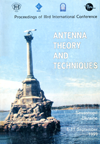One- and two stopband rejection sections based on multiple rectangular aperture irises
DOI:
https://doi.org/10.1109/ICATT.1999.1236279Abstract
Multiple aperture rectangular irises are attractive for the scientists owing to their salient feature to form frequency response with clear total reflection resonance (rejection resonance). A difference of the dimensions of the iris apertures is the condition of the resonance. The simplest two aperture iris forms the frequency response with two resonances of total transmission and one resonance of total reflection, located between them. Numerical studies, carried by us on the base of solving appropriate diffraction problem, show that upper frequency resonance is defined by the slot with lesser width, whereas the resonance at the lower frequency is defined by the slot with larger width. Three aperture iris, cross-section of which contains a pair of equal slots and the other slot of different dimensions has similar frequency response. An influence of changing the geometry of the slots on the frequency response character was studied by us. All the numerical calculations were carried out in the frequency range, corresponding the operating range of the circuit, in which an iris was placed.References
Mos'pan, L.P. Numerical and analytical algorithm for the disign of rejection filters based on multiple aperture irises. Vesnik Dnepropetrovskogo Universiteta. Ser. Fizika, Radioelektronika, 1998, No. 4, p. 133-139.
Sieverding, T.; Arndt, F. Field theoretic CAD of open or aperture matched T-junction coupled rectangular waveguide structures. IEEE Trans. MTT, 1992, Vol. 40, No. 2, p. 33.
Published
1999-09-14
Issue
Section
Microwave components and circuits, fiber-optic links

